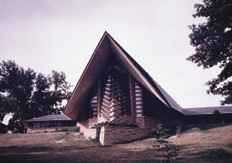Mr. Wright's church turns 50
By Michael A. Schuler

Frank Lloyd Wright's designed his congregation's Meeting House in Madison. Photo courtesy of Edward A. Lynn.
|
The philosopher Max Otto cautioned his fellow Unitarians against idolatry
when they gathered for worship for the first time in their Frank Lloyd
Wright-designed Meeting House in Madison, Wisconsin, in February 1951.
This new edifice, designed by one of the world's leading architects,
must be caught up in our aspiration and thought and action, he said;
the architect's work of art must be absorbed in the art of life.
Truth be told, 50 years ago most members of the small, struggling
Unitarian Society were probably as frustrated as they were pleased
with what seemed to have become an interminable project. Five years
had elapsed since Society member Frank Lloyd Wright had agreed to
the undertaking. Groundbreaking took place in 1949, but construction
proceeded slowly as workers strove to fulfill the requirements of
Wright's bold design.
Indeed, when the congregation convened to worship for the first time
beneath its landmark prow, the Meeting House was still, as Building
Committee Chairman Herb Jacobs recalled, "an uncompleted eyesore
rather than a show place." Another six months would pass before
the stakeholders were satisfied with the results of their considerable
investment.
And what an investment! A project Wright initially estimated at $60,000
ended up costing well over $200,000-a huge sum for a congregation
of less than 200. The price tag would have been much higher had it
not been for the sweat equity of the congregants, considerable sacrifice
by the contractor, and Wright's own unwavering commitment to the project.
After all, it was "his" church they were building.
Wright was born and raised in Wisconsin and spent the last part of
his life there. His mother's family was of staunch Unitarian stock.
His uncle, the Rev. Jenkin Lloyd Jones, led the Western Unitarian
Conference from 1875 to 1884, championing radical directions in Unitarian
thought and worship. His father, William Wright, was also a man of
the cloth. But life as a Baptist minister did not agree with him and
he turned to Unitarianism, becoming secretary of the Madison congregation
when it was organized in 1879.
Frank Lloyd Wright's contribution to Unitarianism includes another
much-admired building, Unity Temple, completed in Oak Park, Illinois,
in 1908. Like the Unitarian Meeting House in Madison, Unity Temple
has no steeple: Wright believed that human interaction with God was
best fostered in the building's interior, on a human scale.
The Meeting House now shelters an active, worshiping congregation
of 1,800. A favored venue for public concerts, recitals, lectures,
and tours, "Mr. Wright's church" draws thousands of admirers
through its distinctive portals each year. Heavy use and the ravages
of time have exacted their toll, however. Basking in the reflected
glory of Frank Lloyd Wright's genius, the Society's membership has
also had to cope with another side of his legacy: the leaking roof.
A major restoration project in the last 10 years required several
hundred thousand dollars to repair electrical service, masonry, plumbing,
caulking, and the like. Now, kitchen pots no longer catch water seeping
through the Hearth Room ceiling on rainy days. Chinks in the great
chimneys have been filled; old fixtures and splintering furniture
have been replaced. At 50, our Meeting House is clearly showing its
age. It has become our home, an irreplaceable spiritual treasure as
well as a work of art.
The Rev. Dr. Michael A. Schuler is senior minister
of the Unitarian Society of Madison. Editorial assistant Jane Greer
contributed to this article.
|
voices from the past
THE MOTHERS OF THE RACE
If there be a feminine side to education and literature, as masculine critics
appear to believe, why should it not be expressed, especially
as women have now so largely entered the ranks of the educated
class? The female half of humanity is a most important half, for
women are the mothers of the race, and for their great work should
have the most thorough training and the highest culture.
Mary A. Livermore, from the Universalist Leader,
June 29, 1901
|
UU World XV:3 (July/August 2001): 72.

